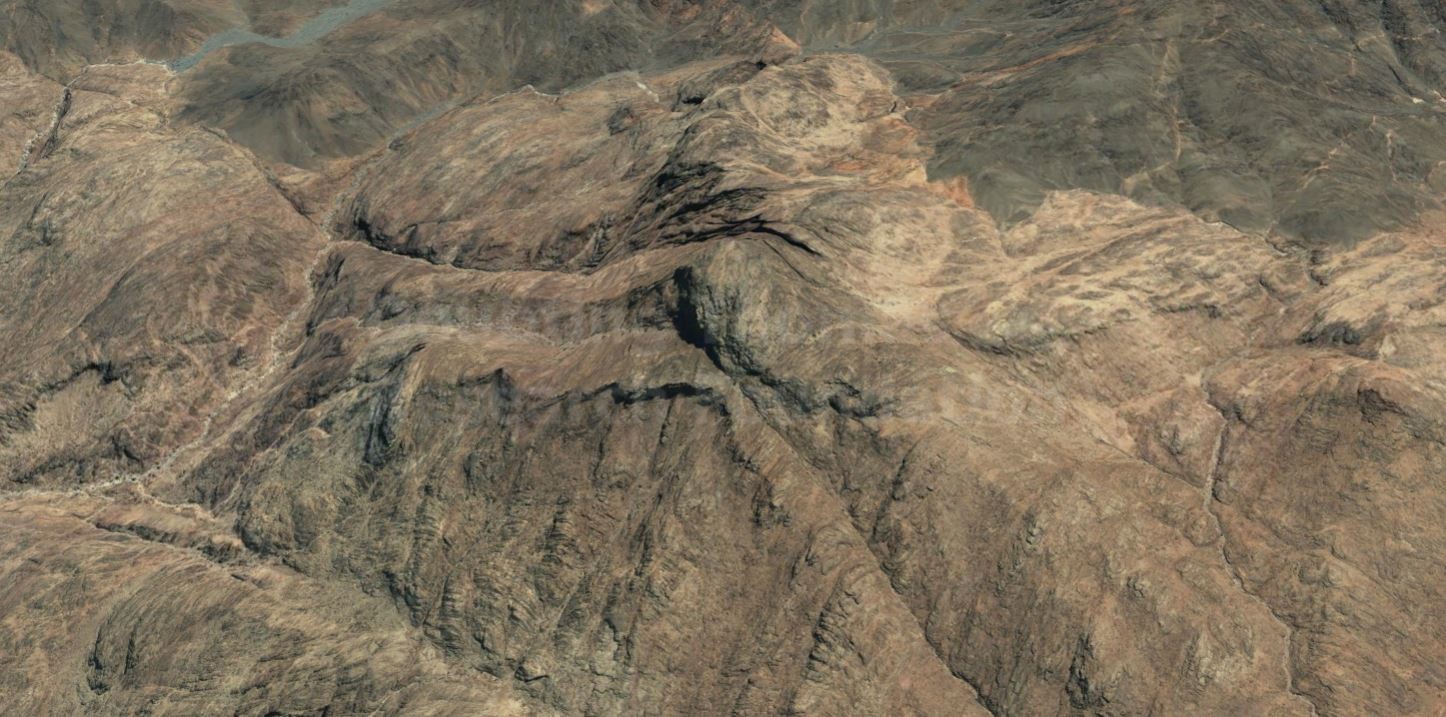Jabal Harb as Mount Sinai

A mountain peak in northwestern Saudi Arabia named Jabal Harb is the best candidate for Mount Sinai, according to Rabbi Alexander Hool. This mountain allegedly has several attributes that he believes demonstrate his theory. He places the Exodus in the Jewish year 2448, or 1312 B.C., which departs from the two mainstream dates for the Exodus (1290 B.C. and 1446 B.C.). Hool rejects the traditional Sinai Peninsula location in Egypt in no uncertain terms and rules out the possibility that Mount Sinai could be located in the Sinai Peninsula.
In his 2016 book, Searching for Sinai: The Location of Revelation, Rabbi Hool identifies Jabal Harb as Mount Sinai. He bases this theory on the Biblical criteria, as well as rabbinical traditions outside of the Torah. He also points out that the name of the mountain resembles that of "Horeb," which is an alternative name for Mount Sinai or the name of an adjacent peak. Hool believes that several features of the mountain and possible evidence of Hebrew encampments supports his thesis.
Hool believes that the Israelites' journey out of Egypt began closer to the Mediterranean Sea than most scholars and theologians do. He identifies Ramesses as the ancient city of "Pelesium" which lay on the shores of the Mediterranean. Pelesium was one of the easternmost cities in the Nile delta, and is referred to by the prophet Ezekiel as "the stronghold of Egypt" (Ezekiel 30:15). In the 26th dynasty and afterward, it was a fortress against Palestine as well as a customs port.
Hool notes that the initial route for the trip by the Way of the Philistines indicates that they were not traveling towards the Sinai Peninsula, but were bypassing this wilderness for a route that would take them down towards the Arabian Peninsula. God, however, led them along another route, because the Israelites may have faced war with the natives in Canaan (Exodus 13:17-18).
He believes that the camps at Succoth, Etham, and the Red Sea all take place at the head of the Gulf of Suez, and that this is where the crossing took place. However, in chapter eleven, he claims that instead of a route from mainland Egypt over to the peninsula, he claims that the Israelites traveled in a semicircle back to the shores from which they came. He asserts that the later encampments by the Red Sea were by the eastern arm, the Gulf of Aqaba

From mainland Egypt, they then doubled back northward and camped at the Great Bitter Lake, which he identifies as Marah in chapter twelve. The next stage of the journey, Elim, is near the head of the Gulf of Aqaba in his estimation.
After Elim, Moses and the Israelites travel slightly southward and camp by the Red Sea, then in the Wilderness of Sin (which he claims also encompasses Dopkah), and then on to Alush, Rephidim, and finally Mount Sinai.
Jabal Harb's Topography
In the book, Rabbi Hool documents an alleged cave near the peak of the mountain, several bushes, one of which could have been the burning bush, remnants of a stream flowing from the mountaintop, a wide plain at the base, and a "suitable" distance from Egypt and Midian.
Rabbi Hool believes that Mount Sinai was not in the land of Midian, but was a fairly long distance away. He bases this assertion on Exodus 4:27, where Moses encounters Aaron at Mount Sinai. The claim is that Moses must have been approximately equidistant from Mount Sinai while in Midian as Aaron was while in Egypt.
In Exodus 4:14, God tells Moses that Aaron is coming to meet him at the mountain, after which he then goes back to Midian, and then returns to Mount Sinai. Rabbi Hool claims that in order for Moses and Aaron to arrive at Mount Sinai at approximately the same time, the total distances traveled would have to be somewhat equal (for Aaron, from Egypt to the mountain; for Moses, from the mountain to Midian, then from Midian back to the mountain).
Jabal Harb sits between ancient Egypt and Rabbi Hool's location for Midian. Whereas the most widely accepted location for Midian is directly east of the Gulf of Aqaba, at the city of al-Bad, Rabbi Hool believes it is much further south, approximately 230 kilometers south of Tabuk, Saudi Arabia near the coastal town of al-Wajh, based on an account from Islamic historian Abu Zejd al-Balhi.
In chapter 19, he notes that there is an Arabian town near Jabal Harb named Al-Horeba, inclining him to believe that Mount Sinai (also called Horeb) must be close to this spot. He also claims that the mountain's name, Jabal Harb, indicates that this is Mount Sinai, as "Harb" is close to "Horeb."
Another alleged piece of evidence is the claim that Moses once lived and ruled in Nubia (south of Egypt) for several decades, and from there traveled to Midian. Hool notes in chapter 5 that the Jewish Yalkut Shimoni recounts such a time, and that after reigning in Nubia, Moses was sent off in great honor to Midian. Directly across the Red Sea from the land of Nubia is Rabbi Hool's proposed location for Midian.

Criticisms
Rabbi Hool relies largely upon Biblical and rabbinic sources for his theory. Among the claims from these rabbinic sources, as mentioned in chapter six, is that Mount Sinai was not a high mountain, but was on the smaller side and was not the highest peak in the region. This conflicts directly with Josephus' record of Mount Sinai being the highest peak in the region and difficult to climb because of its steep slopes.
His location for Midian is also outside what most scholars and theologians believe. There is real and physical evidence of Midianite life in and around al-Bad, whereas Rabbi Hool's location for Midian has some nominal reference (such as Madyn Salich), but he does not present archaeological evidence demonstrating that his location for Midian is the proper one.
One of his pieces of evidence for such a location is the claim that there were two "Midians," which included Midian proper and the land of Moab. In Appendix E, he explains that both Midian and Moab were descendants of their father who was named Midian as well, according to the Midrash Rabbah, and these two people groups were in fairly close proximity.
Moab was in the Dead Sea region. Rabbi Hool's claim is that this history places Midian further south on the Arabian Peninsula. But this does not necessarily have to be the case. The Biblical text does not require Midian being so far south in relation to Moab, and the more mainstream location across from the Gulf of Aqaba at modern-day al-Bad may actually fit the Midrash Rabbah and Biblical accounts more accurately.
Rabbi Hool also claims in chapter 24 of the book that Mount Sinai and Mount Horeb appear to be two mountains, with one on top of the other, according to Jewish tradition. This appears anomalous among opinions regarding the two names for the mountains. Several maps label Horeb and Sinai as two adjacent mountains, not as one. Some interpretations say that the two names are simply interchangeable.
Rabbi Hool's nontraditional methodology for identifying the route of the Exodus and Mount Sinai's location makes him an outlier in the body of research on the subject.
Last updated July 15, 2019

Thanks. You didn’t mention about Harb tribe in the Jabal Harv.